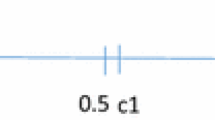Abstract
In many auctions, buyers know beforehand little about objects to be sold in the future. Whether and how to reveal information about future objects is an important decision problem for sellers. In this paper, two objects are sold sequentially and each buyer’s valuation for the second object is k times that for the first one, and the true value of k is sellers’ private information. The authors identify three factors which affect sellers’ revelation strategies: The market’s competition intensity which is characterized by the number of buyers, buyers’ prior information about the second object, and the difference degree between two objects which is characterized by k. The authors give not only conditions under which revealing information about the second object in advance benefits the seller, but also the optimal releasing amount of information in the market with two sellers and one seller, respectively.
Similar content being viewed by others
References
Davis A M, Katok E, and Kwasnica A M, Should sellers prefer auctions? A laboratory comparison of auctions and sequential mechanisms, Management Science, 2014, 60(4): 990–1008.
Lai K K, Ma J, and Wang S Y, On managerial decision problem of the auction sites, Journal of System Science and Complexity, 2006, 19(3): 340–351.
Rao C J, Zhao Y, and Ma S H, Procurement decision making mechanism of divisible goods based on multi-attribute auction, Electronic Commerce Research and Applications, 2012, 11(4): 397–406.
Rao C J and Zhao Y, Multi-stage sequential uniform price auction mechanism for divisible goods, Expert Systems with Applications, 2013, 40(15): 6105–6114.
Haruvy E and Katok E, Increasing revenue by decreasing information in procurement auctions, Production and Operations Management, 2013, 22(1): 19–35.
Colucci D, Doni N, and Valori V, Preferential treatment in procurement auctions through information revelation, Economics Letters, 2012, 117(3): 883–886.
Galor E, Galor M, and Dukes A, Optimal information revelation in procurement schemes, Rand Journal of Economics, 2007, 38(2): 400–418.
Sarne D, Alkoby S, and David E, On the choice of obtaining and disclosing the common value in auctions, Artificial Intelligence, 2014, 215: 24–54.
Milgrom P and Weber R J, A theory of auctions and competitive bidding, Econometrica, 1982, 50(5): 1089–1122.
Krishina V, Auction Theory, Academic Press, San Diego, 2009.
Mares V and Harstad R M, Private information revelation in common-value auctions, Journal of Economic Theory, 2003, 109(2): 264–282.
Szech N, Optimal disclosure of costly information packages in auctions, Journal of Mathematical Economics, 2011, 47(4–5): 462–469.
Bonet M J and Pesendorfer M, Optimal sequential auctions, International Journal of Industrial Organization, 2014, 33: 61–71.
Pitchik C, Budget-constrained sequential auctions with incomplete information, Games and Economic Behavior, 2009, 66(2): 928–949.
Sfrensen S T, Sequential auctions for stochastically equivalent complementary objects, Economics Letters, 2006, 91(3): 337–342.
Jeitschko T D, Equilibrium price paths in sequential auctions with stochastic supply, Economics Letters, 1999, 64: 67–72.
Neugebauer T and Christou P P, Bidding behavior at sequential first-price auctions with (out) supply uncertainty: A laboratory analysis, Journal of Economic Behavior & Organization, 2007, 63: 55–72.
Feng J and Chatterjee K, Simultaneous vs. sequential sales: Bidders competition and supply uncertainty, Decision Support Systems, 2010, 49: 251–260.
Weber R J, Multiple-Object Auctions, New York University Press, New York, 1983.
Author information
Authors and Affiliations
Corresponding author
Additional information
This research was supported by the National Natural Science Foundation of China under Grant Nos. 61273206 and 71471069.
This paper was recommended for publication by Editor ZHANG Xun.
Rights and permissions
About this article
Cite this article
Hu, E., Zhao, Y. & Rao, C. Information revelation in sequential auctions with uncertainties about future objects. J Syst Sci Complex 29, 1617–1628 (2016). https://doi.org/10.1007/s11424-016-4315-1
Received:
Revised:
Published:
Issue Date:
DOI: https://doi.org/10.1007/s11424-016-4315-1




